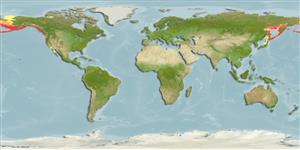Classification / Names
Common names from other countries
Main reference
Size / Weight / Age
Max length : 150 cm TL male/unsexed; (Ref. 40637); common length : 70.0 cm TL male/unsexed; (Ref. 9258); max. published weight: 61.4 kg (Ref. 27547); max. reported age: 9 years (Ref. 12193)
Length at first maturity
Lm 82.2 range ? - ? cm
Environment
Marine; freshwater; brackish; benthopelagic; anadromous (Ref. 51243); depth range 0 - 375 m (Ref. 58426)
Climate / Range
Temperate; ? - 25°C (Ref. 35682), preferred 4°C (Ref. 107945); 72°N - 27°N, 136°E - 109°W (Ref. 54251)
Distribution
Arctic, Northwest to Northeast Pacific: drainages from Point Hope, Alaska to Ventura River, California, USA; occasionally strays south to San Diego in California, USA. Also in Honshu, Japan (Ref. 6793), Sea of Japan (Ref. 1998), Bering Sea (Ref. 2850) and Sea of Okhotsk (Ref. 1998). Found in Coppermine River in the Arctic. Several countries report adverse ecological impact after introduction.
Countries | FAO areas | Ecosystems | Occurrences | Introductions
Short description
Dorsal
spines
(total): 0;
Dorsal
soft rays
(total): 10-14;
Anal
spines: 0;
Anal
soft rays: 13 - 19;
Vertebrae: 67 - 75. Distinguished by the small black spots on the back and on the upper and lower lobes of the caudal fin, and the black gums of the lower jaw (Ref. 27547). Body fusiform, streamlined, noticeably laterally compressed in large adults, somewhat deeper than other species (Ref. 6885). Gill rakers wide-spaced and rough; pelvic fins with axillary process (Ref. 27547). Fish in the sea are dark greenish to blue black on top of head and back, silvery to white on the lower sides and belly; numerous small, dark spots along back and upper sides and on both lobes of caudal; gum line of lower jaw black (Ref. 27547). In fresh water, with the approach of the breeding condition, the fish change to olive brown, red or purplish, the color change being more marked in males than in females (Ref. 27547).
IUCN Red List Status (Ref. 115185)
Threat to humans
Potential pest (Ref. 12257)
Human uses
Fisheries: highly commercial; aquaculture: commercial; gamefish: yes; aquarium: public aquariums
Tools
Special reports
Download XML
Internet sources
Estimates of some properties based on models
Phylogenetic diversity index
PD50 = 0.5000 many relatives (e.g. carps) 0.5 - 2.0 few relatives (e.g. lungfishes)
Trophic Level
4.4 ±0.7 se; Based on diet studies.
Resilience
Medium, minimum population doubling time 1.4 - 4.4 years (tm=4; tmax=9; Fec=4,000)
Vulnerability
High to very high vulnerability (68 of 100)
Price category
